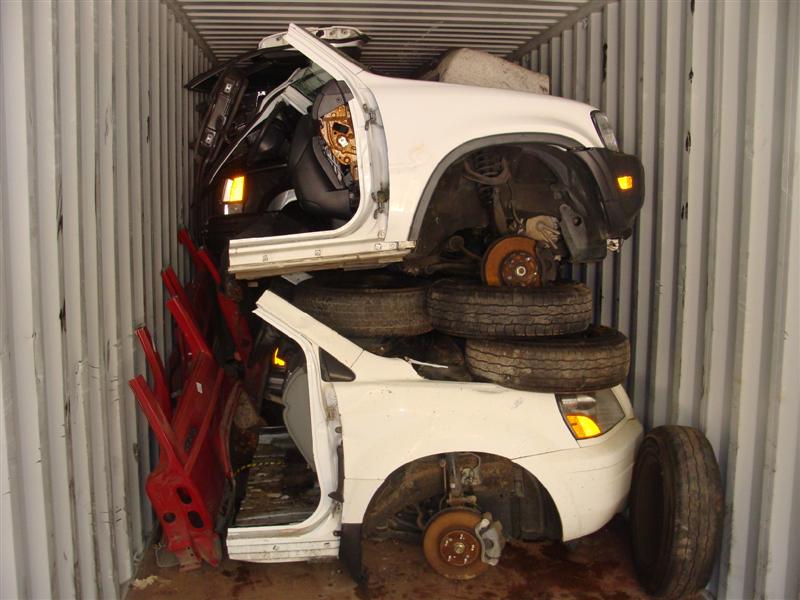When most people think of buying car parts for a project, they either buy a whole car with all the parts included or purchase individual parts, one at a time. However, there's another option called the half-cut, and it could be the answer to all your needs.
A half-cut is the front portion of a car that’s been separated from the rest, including the engine and front suspension and everything surrounding them. In most cases, buying a half-cut is easier and cheaper. Plus, half-cuts are often easier to import and export, simplifying international purchases like JDM car parts.
Half-cuts are an excellent option for many people, yet they’re rarely discussed. This guide will help you understand what they are and how they can benefit you.
What Is a Half Cut When It Comes to Cars?
A car half-cut is exactly what it sounds like: it’s the half portion of a vehicle, cut off and separated from the rest of the whole automobile.
That means all mechanical, interior, and exterior parts go with that cut portion. To be clear, a half-cut includes the following parts from the front portion of the vehicle:
- The engine with its attachments
- The front suspension
- The steering wheel
- The dashboard
- A portion of the car’s dashboard
After being separated, the half portion is stored and made available for purchase. You’ll often find these at places where used car parts are sold, like at wrecking yards and similar automotive businesses.
Car half-cuts need to be transported to their buyer's location, whether that's within the same city or to be shipped cross country.
Once there, the buyer will either dismantle the parts they want or join the half cut with a matching half to form a whole vehicle.
Half Cut Vs Nose Cut—What’s the Difference?
Car half cuts aren’t the only thing you can get from used parts sellers. You may also get a nose cut. The nose cut is also the front portion of a vehicle but excludes parts that some customers might not want.
Not many people know the differences between these terms. That’s why you’ll often find them being used incorrectly to refer to the car portion being sold.
Let’s look closer at the differences between a half cut and a nose cut:
- Half cuts consist of everything in the front half of the car. That includes the engine, part of the interior, the suspension, and more. Half-cuts are more inclusive, consisting of almost everything in the car's front section.
- Nose cuts include everything in the front except for the engine and front suspension. So, it still consists of the headlamps, bumper, grill, top brace, AC condenser, and more. This is ideal if you don't need to purchase an engine or already have one you want to use.
The choice between a half-cut and a nose-cut depends on the project that you’re working on.
For instance, if you already own an engine and suspension parts for your vehicle, purchasing a half-cut would be unnecessary. Getting a nose cut would be a more economical option.
What Are the Benefits of Buying a Half Cut?
Why would anyone want to buy half a car? As it turns out, there is a significant demand for car half-cuts both domestically and internationally. Here are some good reasons to buy a half cut instead of buying parts piece by piece.
- Package deal: Half-cuts are a package deal. They include everything that belongs on that front portion of the vehicle, so you don’t have to buy those components and accessories separately. Think of it as purchasing everything in a set without buying a whole car.
- Maintain quality: Some car models are known for being well-built by their originating factory. So, instead of putting all the pieces together from scratch, buying a half-cut enables you to maintain the original build quality in your finished vehicle.
- Shipping costs: The option of buying a half-portion of a car also cuts down on shipping costs. Whether you’re in the same town, a different state, or overseas, shipping a whole vehicle will be very expensive. While it’s still be pricey to transport a half-cut, it will be significantly cheaper overall.
- Import and export restrictions: Lastly, half cuts are so popular because they're a workaround when dealing with import and export restrictions. Most countries have tight rules about importing whole vehicles, making things challenging for buyers and sellers alike. Half cuts technically aren't vehicles at all, making it possible to avoid those restrictions and reduce associated costs.
Are Half Cuts Available in Australia?
Yes, half-cuts in Australia are very common and easy to get your hands on. A perfect place to begin your search is to check your local auto wreckers to see what they have on offer.
Many wrecking yards have half-cuts ready for sale. Even if they don't, they'll know where you can find the half-cuts you need in the local area. For starters, why not try Woodville Auto Wreckers or Niss 4x4 Auto Spares?
JDM half cuts in Australia are also available for those looking to work on Japanese project cars. However, the best way to find Japanese half cuts is through your preferred JDM parts importers, who often import those cuts directly from Japan.
Whether you’re looking for European car half-cuts in Brisbane or Japanese half-cuts in Perth, you can find the right contacts through the Directory at CarpartAU. The Directory is easy to use, allowing you to quickly filter the kinds of automotive businesses you want from the menu.
Search for wreckers and other specialist businesses to get your hands on the half-cuts you need!
By Ray Hasbollah

